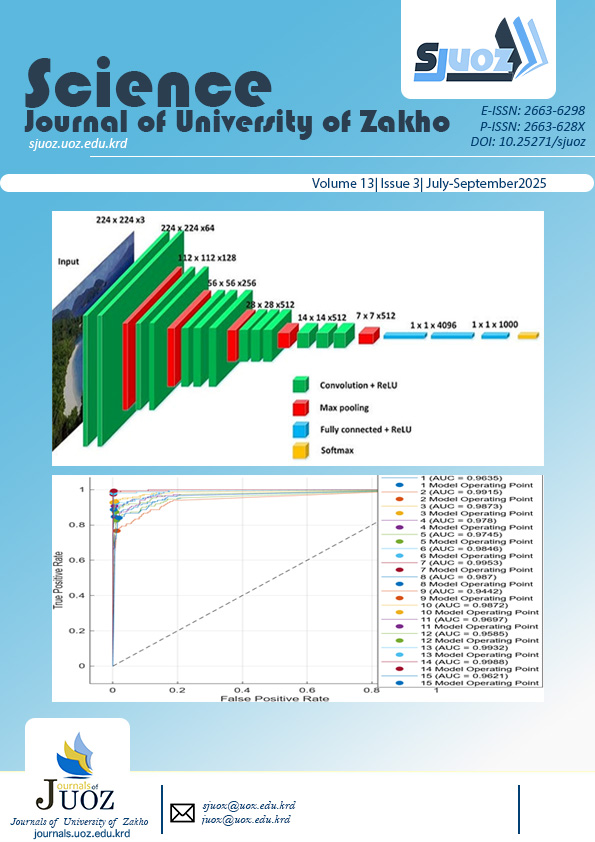ON NIL-SYMMETRIC RINGS AND MODULES SKEWED BY RING ENDOMORPHISM
Abstract
The symmetric property plays an important role in non-commutative ring theory and module theory. In this paper, we study the symmetric property with one element of the ring and two nilpotent elements of skewed by ring endomorphism on rings, introducing the concept of a right - -symmetric ring and extend the concept of right - -symmetric rings to modules by introducing another concept called the right - -symmetric module which is a generalization of -symmetric modules. According to this, we examine the characterization of a right - -symmetric ring and a right - -symmetric module and their related properties including ring and explore their connections to other classes of rings and modules. Furthermore, we investigate the concept of - -symmetric on some ring extensions and localizations like Dorroh extension, Jordan extension and module localizations like
Full text article
References
Agayev, N., Halıcıoğlu, S., & Harmancı, A. (2009). On symmetric modules. Riv. Mat. Univ. Parma, (8) 2,91-99. https://www.researchgate.net/publication/258838045
Agayev, N., & Harmancı, A. (2007). On semicommutative modules and rings. Kyun. Math. Jour. 47, 21-30. https://www.researchgate.net/publication/264133958
Anderson, D. D., & Camillo, V. (1999). Semigroups and rings whose zero products commute. Communications in Algebra, 27(6), 2847–2852. https://doi.org/10.1080/00927879908826596.
Armendariz, E. P. (1974). A note on extensions of Baer and PP-rings. Journal of the Australian Mathematical Society, 18(4), 470–473. https://doi.org/10.1017/S1446788700029190
Başer, M., Hong, C. Y., & Kwak, T. K. (2009). On extended reversible rings. Algebra Colloquium, 16(01), 37–48. https://doi.org/10.1142/S1005386709000054
Buhphang, A. M., & Rege, M. B. (2002). Semi-commutative modules and Armendariz modules. Arab. J. Math. Sci, 8, 53–65. https://www.researchgate.net/publication/266169679.
Chakraborty, U. S., & Das, K. (2014). On Nil‐Symmetric Rings. Journal of Mathematics, 2O14(1),483784. https://doi.org/10.1155/2014/483784.
Cohn, P. M. (1999). Reversible rings. Bulletin of the London Mathematical Society, 31(6), 641–648. https://doi.org/10.1112/S0024609399006116.
Dorroh, J. L. (1932). Concerning adjunctions to algebras. https://projecteuclid.org/journals/bulletin-of-the-american-mathematical-society/volume-38/issue-2/Concerning-adjunctions-to algebras/bams/1183495749.pdf
Harmanci, A., Kose, H., & Ungor, B. (2021). Symmetricity and reversibility from the perspective of nilpotents. Communications of the Korean Mathematical Society, 36(2), 209–227. https://doi.org/10.4134/CKMS.c200209
Hong, C. Y., Kim, N. K., & Kwak, T. K. (2000). Ore extensions of Baer and pp-rings. Journal of Pure and Applied Algebra, 151(3), 215–226. https://doi.org/10.1016/S0022-4049(99)00020-1
Huh, C., Kim, H. K., Kim, N. K., & Lee, Y. (2005). Basic examples and extensions of symmetric rings. Journal of Pure and Applied Algebra, 202(1–3), 154–167. https://doi.org/10.1016/j.jpaa.2005.01.009
Jordan, D. A. (1982). Bijective extensions of injective ring endomorphisms. Journal of the London Mathematical Society, 2(3), 435–448. https://doi.org/10.1112/jlms/s2-25.3.435
Krempa, J. (1996). Some examples of reduced-rings. Algebra Colloq, 3(4), 289–300. https://www.researchgate.net/profile/Jan-Krempa/publication/265588920_Some_examples_of_reduced_rings/links/5793127608aed51475b9fb58/Some-examples-of-reduced-rings.pdf
Kwak, T.-K. (2007). Extensions of extended symmetric rings. Bulletin of The Korean Mathematical Society, 44(4), 777–788. https://doi.org/10.4134/BKMS.2007.44.4.777
Lambek, J. (1971). On the representation of modules by sheaves of factor modules. Canadian Mathematical Bulletin, 14(3), 359–368. https://doi.org/10.4153/CMB-1971-065-1
Lee, T.-K., & Zhou, Y. (2004). Reduced modules. Rings, Modules, Algebras and Abelian Groups, 236, 365–377. https://www.researchgate.net/profile/Tsiu-Kwen-Lee/publication/258223555_Reduced_Modules/links/5c664c6745851582c3e97c91/Reduced-Modules.pdf
Marks, G. (2002). Reversible and symmetric rings. Journal of Pure and Applied Algebra, 174(3), 311–318. https://doi.org/10.1016/S0022-4049(02)00070-1
Mohammadi, R., Moussavi, A., & Zahiri, M. (2012). On nil-semicommutative rings. International Electronic Journal of Algebra, 11(11), 20–37. https://dergipark.org.tr/en/download/article-file/232807
Raphael, R. (1975). Some remarks on regular and strongly regular rings. Canadian Mathematical Bulletin, 17(5), 709–712. https://doi.org/10.4153/CMB-1974-128-x
Rege, M. B., & Chhawchharia, S. (1997). Armendariz rings. Proc. Japan Acad. Ser. A Math. Sci. Proc. Vol. 73(A). https://projecteuclid.org/journals/proceedings-of-the-japan-academy-series-a-mathematical-sciences/volume-73/issue-1/Armendariz-rings/10.3792/pjaa.73.14.pdf
Shin, G. (1973). Prime ideals and sheaf representation of a pseudo symmetric ring. Transactions of the American Mathematical Society, 184, 43–60. https://doi.org/10.1090/S0002-9947-1973-0338058-9
Agayev N., Halicioğlu S. & Harmanci A. (2009). On Reduced Modules. Commun. Fac. Sci. Univ. Ank. Series, 1 , 9-16. https://dergipark.org.tr/en/download/article-file/771531
Suarez H., Higuera S. & Reyes A. (2024). On Σ-skew Reflexive-Nilpotents-Property for Rings. Algeb. Disc. Math. v. 37, N 1, pp. 134-159. https://doi.org/10.48550/arXiv.2110.14061
Hassan, R. M., & Awla, S. H. (2025). SMARANDACHE ANTI ZERO DIVISORS. Science Journal of University of. Zakho. 13(1). 52-57. https://doi.org/10.25271/sjuoz.2025.13.1.1342
Haso, K. S., & Khalaf, A. B. (2022). On Cubic Fuzzy Groups and Cubic Fuzzy Normal Subgroups. Science Journal of University of Zakho, 10(3), 105–111. https://doi.org/10.25271/sjuoz.2022.10.3.907
Authors
Copyright (c) 2025 Ibrahim Adnan Mustafa, Chenar Abdulkareem Ahmed

This work is licensed under a Creative Commons Attribution 4.0 International License.
Authors who publish with this journal agree to the following terms:
- Authors retain copyright and grant the journal right of first publication with the work simultaneously licensed under a Creative Commons Attribution License [CC BY-NC-SA 4.0] that allows others to share the work with an acknowledgment of the work's authorship and initial publication in this journal.
- Authors are able to enter into separate, additional contractual arrangements for the non-exclusive distribution of the journal's published version of the work, with an acknowledgment of its initial publication in this journal.
- Authors are permitted and encouraged to post their work online.

